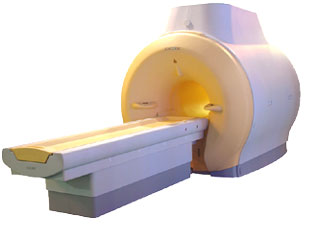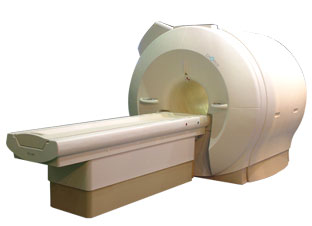 | Info
Sheets |
| | | | | | | | | | | | | | | | | | | | | | | | |
 | Out-
side |
| | | | |
|
| | | | | |  | Searchterm 'Spin' was also found in the following services: | | | | |
|  |  |
| |
|

'MRI system is not an expensive equipment anymore.
ENCORE developed by ISOL Technology is a low cost MRI system with the advantages like of the 1.0T MRI scanner. Developed specially for the overseas market, the ENCORE is gaining popularity in the domestic market by medium sized hospitals.
Due to the optimum RF and Gradient application technology. ENCORE enables to obtain high resolution imaging and 2D/3D Angio images which was only possible in high field MR systems.'
- Less consumption of the helium gas due to the ultra-lightweight magnet specially designed and manufactured for ISOL.
- Cost efficiency MR system due to air cooling type (equivalent to permanent magnetic).
- Patient processing speed of less than 20 minutes.'
Device Information and Specification
CLINICAL APPLICATION
Whole body
CONFIGURATION
Short bore compact
| |  | | | | | | | | |
|  |  | Searchterm 'Spin' was also found in the following services: | | | | |
|  |  |
| |
|
Quantification relies on inflow effects or on spin phase effects and therefore on quantifying the phase shifts of moving tissues relative to stationary tissues.
With properly designed pulse sequences (see phase contrast sequence) the pixel by pixel phase represents a map of the velocities measured in the imaging plane. Spin phase effect-based flow quantification schemes use pulse sequences specifically designed so that the phase angle in a pixel obtained upon measuring the signal is proportional to the velocity. As the relation of the phase angle to the velocity is defined by the gradient amplitudes and the gradient switch-on times, which are known, velocity can be determined quantitatively on a pixel-by-pixel basis. Once, this velocity is known, the flow in a vessel can be determined by multiplying the pixel area with the pixel velocity. Summing this quantity for all pixels inside a vessel results in a flow volume, which is measured, e.g. in ml/sec.
Flow related enhancement-based flow quantification techniques (entry phenomena) work because spins in a section perpendicular to the vessel of interest are labeled with some radio frequency RF pulse. Positional readout of the tagged spins some time T later will show the distance D they have traveled.
For constant flow, the velocity v is obtained by dividing the distance D by the time T : v = D/T. Variations of this basic principle have been proposed to measure flow, but the standard methods to measure velocity and flow use the spin phase effect.
Cardiac MRI sequences are used to encode images with velocity information. These pulse sequences permit quantification of flow-related physiologic data, such as blood flow in the aorta or pulmonary arteries and the peak velocity across stenotic valves. | |  | |
• View the DATABASE results for 'Flow Quantification' (6).
| | | | |
|  | |  |  |  |
| |
|
The dephasing of the protons is named the T2, spin- spin or transverse relaxation.
The T2 time constant is the time taken for spinning protons to lose phase coherence among the nuclei spinning perpendicular to the main field. This interaction between spins results in a reduction in the transverse magnetization. The value of T2 depends on the mobility of the protons. A large mobility results in an average magnetic field variation of zero, resulting in a long T2 period of this tissue.
See also T2 Time. | | | |  | |
• View the DATABASE results for 'T2 Relaxation' (17).
| | | | |  Further Reading: Further Reading: | | Basics:
|
|
News & More:
| |
| |
|  |  | Searchterm 'Spin' was also found in the following services: | | | | |
|  |  |
| |
|
When a group of spins is placed in a magnetic field, each spin aligns in one of the two possible orientations. The relative numbers of spins with different alignments will be given by the Boltzmann distribution.
Definition: if a system of particles, which are able to exchange energy in collisions is in thermal equilibrium, then the relative number ( population) of particles, N1 and N2, in two particular energy levels with corresponding energies, E1 and E2, is given by N1/N2 = exp [-(E1 - E2)/kT] where k is the Boltzmann constant and T is the absolute temperature.
For example, in NMR of protons at room temperature in a magnetic field of 0.25 tesla, the difference in relative numbers of spins aligned with the magnetic field and against the field is about one part in a million; the small excess of nuclei in the lower energy state is the basis of the net magnetization and the resonance phenomenon. | |  | |
• View the DATABASE results for 'Boltzmann Distribution' (4).
| | | | |
|  |  | Searchterm 'Spin' was also found in the following services: | | | | |
|  |  |
| |
|

'Next generation MRI system 1.5T CHORUS developed by ISOL Technology is optimized for both clinical diagnostic imaging and for research development.
CHORUS offers the complete range of feature oriented advanced imaging techniques- for both clinical routine and research. The compact short bore magnet, the patient friendly design and the gradient technology make the innovation to new degree of perfection in magnetic resonance.'
Device Information and Specification
CLINICAL APPLICATION
Whole body
Spin Echo, Gradient Echo, Fast Spin Echo,
Inversion Recovery ( STIR, Fluid Attenuated Inversion Recovery), FLASH, FISP, PSIF, Turbo Flash ( MPRAGE ),TOF MR Angiography, Standard echo planar imaging package (SE-EPI, GE-EPI), Optional:
Advanced P.A. Imaging Package (up to 4 ch.), Advanced echo planar imaging package,
Single Shot and Diffusion Weighted EPI, IR/FLAIR EPI
STRENGTH
20 mT/m (Upto 27 mT/m)
| |  | |
• View the DATABASE results for 'CHORUS 1.5T™' (2).
| | | | |
|  | |  |  |
|  | |
|  | | |
|
| |
 | Look
Ups |
| |